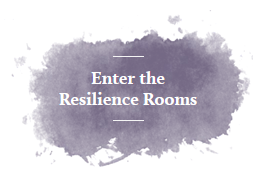I often refer to our chatty mind. OUR relentless mind that typically chimes sentiments of concern, worry, fear, disappointment and frustration. Our mind’s level of chattiness varies. I encourage you to ask yourself how chatty is your mind? If it’s not readily clear, watch and observe your thoughts and feelings. Learn about the complexities of your thoughts and feelings. Our thoughts are filled with rich perceptions, evaluations, judgments, and expectations. A struggle to avoid, get rid of, and an internal “wish” that those thoughts and feelings didn’t exist perpetuates a mind loop where we end up having thoughts about our thoughts and feelings about our feelings. For some, this mind loop can be exhausting, painful and frustrating. It can be challenging to have self-compassion when all of that “noise” is surfacing causing us to question, defend against and desire to avoid ourselves.
I blatantly ask some of my patients in that very moment to “stop” having the thoughts and feelings that they are having. They smirk. There is no way to “get rid” of the thoughts and feelings, just to lower the volume so life can be lived more meaningfully. Our minds do what they do. They are wired that way and each of us have complex individualized electrical systems. There is a continuum representing how chatty our minds are, whether we act more or less from our intellect (Pre-Frontal Cortex) vs our emotions (Amygdala), and how negative our thinking innately is.
An example came up with my six year old daughter last week that I thought was a good illustration of where our minds go despite where we would prefer it going. My three sons were away at sleep away camp for a month. I spoke with her about the transition of them coming back and she expressed delight that they were coming home and expressed how much she missed them being away.
We picked them up on a Sunday. She hugged them and visually it was apparent how much she missed them and felt gratitude that they were home. Her pleasant mood didn’t last very long. She became irritable, clingy, and aggressive. She was not much fun to be around and there was a consensus among the boys that she was “annoying.” It prompted me to want to take immediate action to stop her behavior because she was irritating and unpleasant to deal with. I was in touch with finding her behavior annoying too! I mindfully chose not to act on these thoughts because I knew if I yelled at her and criticized her behavior that it would have only made matters worse and that she would only become more irritable and irritating.
I pulled her aside and said, “I noticed your mood suddenly changed. Are you worried that mommy and daddy aren’t going to give you as much attention as you were getting when the boys were away? Also, that we’ll have to pay attention to the boys and will sometimes forget about you?” She skeptically answered and said emphatically, “yes.” I said, “You were so happy that the boys were coming home and it seems like now that they are here it’s harder than you thought it would be.” She said, “Yes, I want them to go back to camp. I don’t want them to be here.”
I said, “It must feel uncomfortable to feel that way, especially because you love them so much. It’s okay to have those feelings. They are just feelings. You can still love them and feel that way toward them. You may not feel like you like them very much right now. That’s okay too. Our feelings come and go.”
I further said, “I want to be here for you if that’s what you need from me. It’s hard for me to hear you when you’re whining, crying, screaming and demanding my attention. I’ll have to give them attention at times, like I give to you but if you want and need my attention, if you let me know in a way that I can hear you by asking respectfully and saying please, I will always do my best to pay attention to you.”
In a matter of minutes she was back to her jovial self. I helped her connect her thoughts, feelings and actions. I supported her thoughts and feelings by providing nurturance and acceptance and let her know that thoughts and feelings are fleeting. Also that it isn’t necessarily reflective of how she sees or identifies who she is (irritable and annoying). This allowed her to be who she is while setting appropriate boundaries around her behavior and fostering and teaching positive communication skills.
I truly wish I had this support when I was growing up. This awareness and integration of skills has been magical for me. When I verbalize to my patients that how they think and feel IS OKAY and that THEY ARE OKAY, from the emotions that follow suit, it’s evident that they either never heard this, believed or internalized it or potentially hadn’t entertained the sentiments.
HOW OUR MIND HAS A MIND OF ITS OWN:
- Our mind holds onto formative ways of thinking, feeling and coping. When I ask people “how old” their thought is, it’s usually an old thought going way back to childhood. The thought and/or feeling is familiar, comfortable, and what the person’s used to. These thoughts may have been extremely purposeful in childhood but sometimes doesn’t accommodate the person’s development as they mature into adulthood.
- Notice those “old” thoughts and feelings. Observe the consistent patterns and whether they pertain to the present set of circumstances. Evaluate for yourself whether you’re falling back into these older patterns or whether the circumstances would naturally evoke those set of thoughts and feelings. Also, assess if you tend to fall into those typical ways of reacting and acting on behalf of those thoughts and feelings. Re-assess if that’s in fact how you want to be acting. We may not have control over our thoughts and feelings but we can make choices about our behavior.
- Recognize which core beliefs those thoughts and feelings hit up against. Is it ineffectiveness? unloveability? and/or hopelessness? Do they tend to hit up against one or another? Remain consistent or change based on the circumstance?
- On the continuum, individuals who are anxious are more apt to have “chattier” minds. They tend to be flooded with anticipatory anxiety (before), anxiety in the moment (during) and postpartum anxiety (after). The cycle appears with “____ will happen”, “what ifs” and “I should/could haves.”
- Our mind is relentless at protecting us. It provides us with safety at all times – even when it’s not necessarily warranted. The safety I speak of includes protection from rejection, pain, disappointment, etc. Thank your mind for this! The “what ifs” are purposeful. For example, if we didn’t think “I’m going to fail the test” we may not be prompted to study. The challenge presents itself when the thought “I’m going to fail” becomes all-encompassing and impacts on a person’s self-confidence and ability to effectively study and concentrate on the material.
- Based on our mind’s protective mechanism, it tends to be naturally negative and goes to those dreaded places of looking at things through a negative lens. The wave of “positive thinking” gratitude journaling and “mindfulness” is in an effort to be in the present and retrain and open the mind to other possibilities. In the type of work I do (ACT), we call it “psychological flexibility.” I ask my patients, how else can they see it? What are other possibilities? It helps to open and expand the mind.
- Don’t believe everything you think. I have a sign with these words on my office door. Be cautious at accepting your thoughts as facts. Observe your thoughts, be curious about them, notice your judgments and ask how else can things or circumstances be considered?
- We are taught to be happy (“happily ever after”), “fix things that are broken”, “get rid of “bad” feelings and hold on to only the “good” ones”, and “what we “think” or “feel” is reflective of who “we are.” With all this being said it makes it difficult for us to “BE OKAY” because rarely all of this falls into place. Part of our intrinsic humanness is acceptance of all that we are and are presented with, including the more comfortable and less comfortable thoughts and feelings. I always refer to it this way — never suggesting good and bad. That connotes that if we have bad thoughts than we’re bad and if we have good thoughts than we’re good. If this were the case my humanness would dictate that I am very bad because less comfortable thoughts are consistently evoked.
- We all strive to be accepted and sought after and want to believe that we’re not causing someone else pain or discomfort. There lies why we get confused and have conflicting thoughts and feelings about our “selfishness” and our need for “self-preservation.” When we perceive ourselves as being “selfish”, we experience ourselves as being mean, self-centered/serving and non-caring. Evaluate if you’re doing something for yourself and are also considering the impact on others. Accept that sometimes we need to make decisions that are based on our own needs for the sake of self-preservation, despite whether it impacts others. You could evaluate if you are acting mindfully and thoughtfully.
I went to lunch with my friend last week who happens to be a psychologist and she asked me, “How are you able to expose yourself by writing the blogs you do? I couldn’t ever do that.” I asked her why she felt she couldn’t. She said that she was reluctant to expose her deep intense thoughts and feelings for fear of being judged.
I explained to her that the reason that I can put myself out there, expose myself and be vulnerable is because of accepting, appreciating and being relatively in touch with my “humanness.” Part of me accepting my “humanness” is allowing and appreciating the “humanness” of others inclusive of their thoughts, feelings, perceptions and judgments of me. I try my best to approach the world with general acceptance, openness, and curiosity with the understanding that we’re ALL afforded with the full array of thoughts and feelings; inclusive of the more comfortable and less comfortable ones.
Along with my shame and guilt, I often laugh at myself for my “meanness” “inappropriateness” and “thoughtlessness.” I try my utmost to act in accordance with my values rather than my thoughts and feelings. I usually give myself a minute to process before I act. To center myself I’ll recite the word “value” in my head, earmark which value is operating, think about the actions that go along with that value and act in line with that value. This takes work, practice, and personal conscientiousness.
My darling daughter; her maturity doesn’t allow for her to process all of this independently so I try to make the connections for her. What a priceless moment for me the other day when I was driving her and her friend and she leaned in toward her friend and said, “We all make mistakes, it’s part of our humanness.” She warmed my heart!



